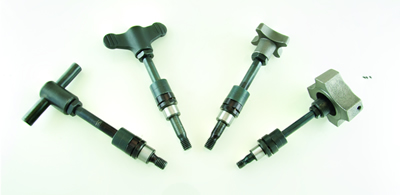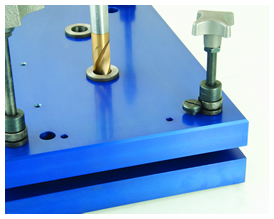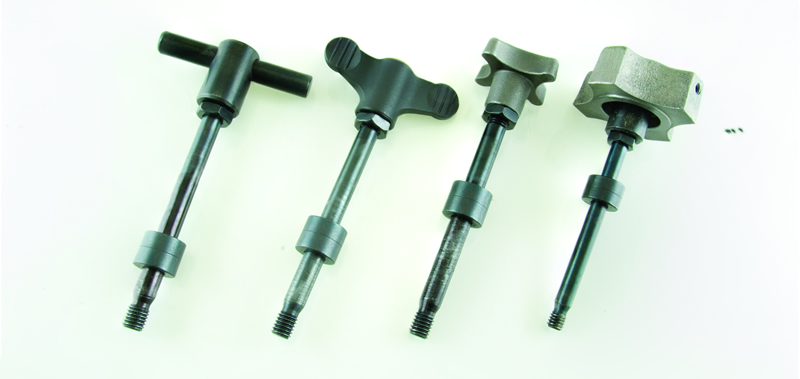Improving aerospace fabrication with flexibility
Now a tired and tested method for securing fixtures and jigs used in aircraft construction, clamping pins enable quick and easy loading and unloading of large parts. However, in their traditional designs they are not without flaws, which prompted WDS Component Parts to use its workholding expertise to look for improvements. Phil Holyome, Business Development and Special Projects Engineer at WDS Component Parts, elaborates on the process.
Unsurprisingly, throughout the aerospace industry, accuracy is the absolute watchword. Further, time management and addressing space constraints are also critically important. Removable jig plates make it easy to replicate processes from one structural part to another. Also when the parts are loaded onto a jig bed they can be quickly and securely clamped in position.
The time-honoured method for loading and unloading large jigs is to combine precision-ground retention bushes with clamping pins. The bush is positioned and held in place using a standard shoulder screw. A clamping pin will then pass through the positioning hole and screw into threaded holes on the machine bed to hold the jig in place.
However, while this is a tried and tested method which yields good results, there are inefficiencies which are well documented. For instance, traditional clamping pins may become dislodged when the jig is being moved, which can result in the pin becoming lost. Time spent looking for the pin is time wasted and can lead to more delays elsewhere in the aircraft construction process. Of course if the part cannot be found and needs to be replaced, that is an additional cost. While each occurrence would be classed as a minor annoyance, it can begin to add up. This is why one manufacturer asked WDS to develop a retained clamping pin design.
Captive clamping pins aren’t a new concept to the market of course. Typically a small leaf spring is used to hold the pin in place. Located in the positioning element to combine with a notch at the tip of the clamp’s shaft, as the clamp is removed from the jig bed, the spring tightens around the notch and holds the clamping pin in place.
This means the clamp will not become accidentally dislodged when the jig is moved. The pin is held in place at all times, even if the jig is subjected to vibrations or turned upside down. However, once again this design is not without fault. It is not uncommon for the leaf spring to come loose when the pin is removed from the jig. In a busy manufacturing environment, when this happens it is almost impossible to find and a new pin must be used.
During a discussion with a major British aerospace manufacturer, WDS was asked to develop a new captive clamping design which would fix the leaf spring glitch. WDS examined all of the different products on the market and developed a design which would offer several distinct advantages.
Firstly, the leaf spring and notch has been designed so that the spring is inherently ‘self-retained’. The pin can be re-used on multiple assembly jigs with no risk of the spring becoming dislodged and lost. This reduces wastage during assembly and helps to maintain efficiency productivity, which is vital in any busy production environment.
The WDS range has also been developed to be as flexible as possible at the point of set-up. To further this, the collar is mobile on the pin when it’s delivered. This allows the end user to modify the shaft length to fit the depth of the fixing plate – once the suitable length is found the collar can be welded in position or the shaft can be cross drilled and pinned.
Flexibility is also present at the point of specification. With other clamping pins on the market, both traditional and captive, there is typically a single handle choice, a T-handle. This is unsuitable in many applications where there are space restraints and engineers often find that they have to manually remove the handle themselves and fix a replacement in. WDS offers a choice of four handles as standard with its range: a traditional T-handle, a steel hand knob, a plastic handle or an adjustable torque knob. The choice is further complemented with the option to specify a bespoke handle from the entire WDS range, as well as the option to order a clamping pin with no handle fitted. All options are available ‘out of the box’, meaning that the pins are delivered ready to go.
When the new design was presented to the customers they could see immediately how the combined design features increase the usefulness of clamping pins even further on jigs for aircraft construction, delivering greater flexibility while ensuring improved longevity. In particular, the captive element combined with the self-retained spring adds a new level of reliability and speed to plate change processes.








